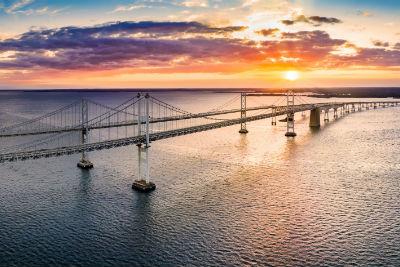
Gov. Ralph Northam signed an executive directive Thursday setting pollution reduction targets for lands within the Chesapeake Bay watershed that are owned by state agencies and public institutions of higher education.
Nonpoint source pollution, also known as polluted runoff, occurs when stormwater moves over the ground collecting pollutants like excess nutrients, sediment, and toxins that degrade water quality and harm living resources.
“Stormwater runoff is among the most harmful and challenging sources of pollution to the Chesapeake Bay and its tributaries,” Northam said. “Virginia has taken bold action to reduce nutrient and sediment pollution and we have made meaningful progress, but we must step up these efforts to achieve our clean water goals by 2025. As one of the largest landowners in the Bay watershed, this directive will ensure that the Commonwealth leads by example.”
In 2019, Virginia released its Phase III Watershed Implementation Plan to achieve the Chesapeake Bay Total Maximum Daily Load by 2025 that included a commitment to develop a plan specific to state lands. Over the past year, a team of experts from state agencies and public institutions from higher education worked at the direction of the governor’s Conservation Cabinet to produce a State Lands Watershed Implementation Plan by mapping state lands, calculating runoff pollution targets, and identifying conservation practices that when implemented will reduce nutrient and sediment pollution.
The goal of the SWIP is to achieve significant reductions in, or to offset unregulated, nonpoint source pollution originating from state lands within Virginia’s Chesapeake Bay watershed. The SWIP required the development of a comprehensive dataset of over 400,000 acres of state lands within the Chesapeake Bay watershed and calculation of pollution load reductions using the Chesapeake Bay Watershed model.
The SWIP details reduction targets of 122,000 pounds of nitrogen and 10,100 pounds of phosphorus and specifies eleven programmatic actions to achieve success.
“State agencies and institutions of higher education must take the same steps to restore the Chesapeake Bay that the Commonwealth is expecting of farmers, homeowners, private businesses, and local governments,” said Secretary of Natural Resources Matthew J. Strickler. “If we make reducing pollution part of everyday business in Virginia, we will ensure that future generations can enjoy and benefit from healthy rivers and a cleaner Bay.
Executive Directive Seventeen orders the Secretary of Natural Resources, in partnership with the Secretary of Administration, Secretary of Public Safety and Homeland Security, and the Conservation Cabinet, to ensure that the SWIP is fully implemented by all Virginia agencies, public institutions of higher education, and other state governmental entities that own or manage land within Virginia’s Chesapeake Bay watershed.
The full text of Executive Directive Seventeen is available here. The State Lands Watershed Implementation Plan can be found here.










